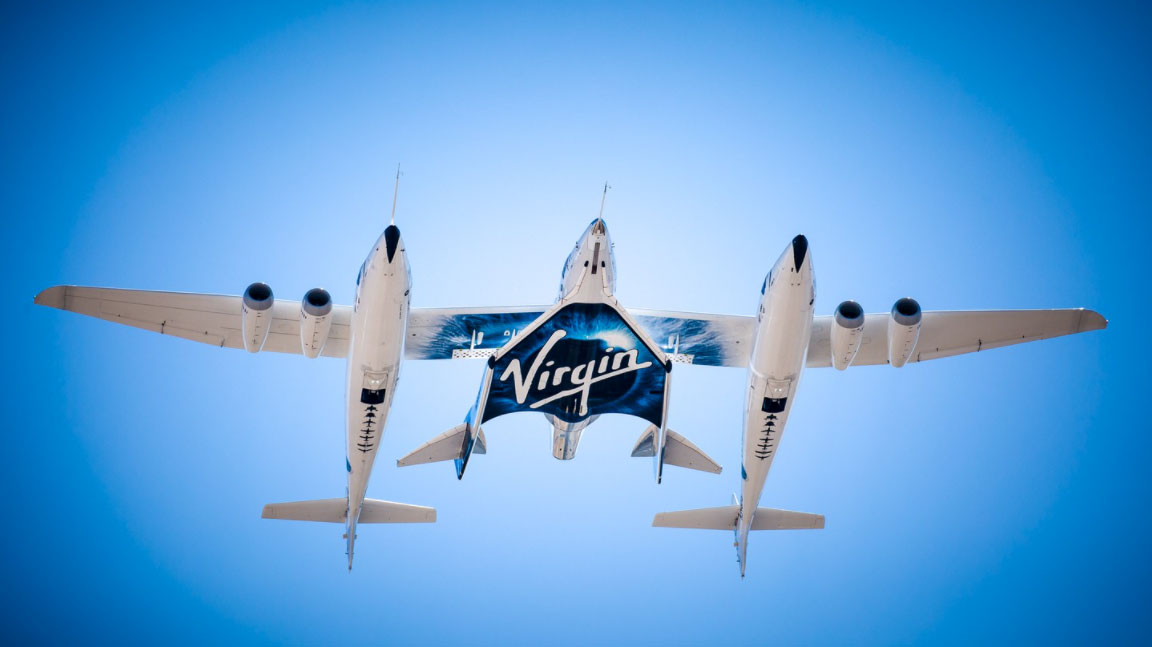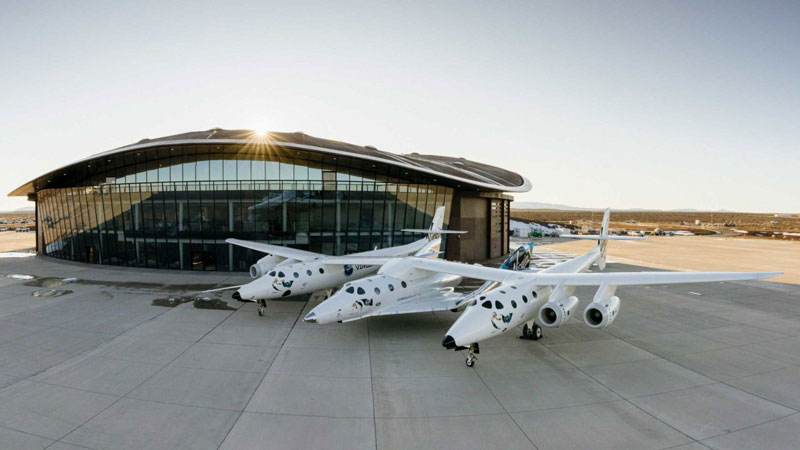All You Need To Know About Virgin’s Space Ship Two
The race to put commercial passengers into space seems at times to be dominated by mega billionaire Americans. Elon Musk’s SpaceX and Jeff Bezos’s Blue Origin are stealing all the headlines with their remarkable footage of docking with space stations and impressive returns to Earth of their re-usable rockets. But let’s not forget that us Brits also have a billionaire mogul who has his eyes on the prize…
Sir Richard Branson is the head of Virgin Galactic, and he also is planning to provide regular flights into space for intrepid tourists. Things have been a little quiet on the news front from this company in recent months. This is a little unusual to say the least, as Sir Richard is renowned for enjoying the limelight and is certainly not averse to a well-timed publicity stunt or two. But rest assured the company is working relentlessly in the background, and many industry pundits think that Virgin Galactic are closer than many think to launching that first commercial passenger carrying flight into space.
Branson is taking a radically different approach to his two American rivals. Instead of their rocket focused designs, Virgin Galactic are planning an aircraft / space plane combination, with their SpaceShipTwo craft providing the means of travelling beyond earth’s atmosphere into the blackness and weightlessness beyond.
Ever the optimist, he initially suggested that he expected to see his company’s inaugural flight into space in 2009. A decade later, his ambitions remain unfulfilled after a series of further deadlines, delays and setbacks. But there is no doubt that he is closer than ever to achieving his life’s dream. A number of test flights have already taken his spaceplane almost as far as the recognised border of space: the Karman Line, which is 100km above sea level. Speeds of over three times the speed of sound (Mach 3) have also been achieved.

History and Development of SpaceShipTwo
Virgin Galactic was founded back in 2004. Sir Richard Branson had already been knighted in 2000 for services to entrepreneurship. Amongst his many business successes was his market disrupting airline Virgin Atlantic. He was also renowned for a variety of daredevil record breaking balloon flights. Given this background, it should not have been much of a surprise that he decided to extend his horizons to the space race.
His space plane, SpaceShipTwo, was first unveiled at the Virgin Galactic Base in the Mojave Desert in the United States in late 2009. Initial flights had already been booked by more than three hundred prospective passengers, at a cool $200,000 per ticket. Sir Richard’s ultra-positive, gung-ho approach was excellent at drumming up publicity and advanced bookings. By 2014, the company had already raised around $80 million in deposits and ticket sales. However, it was less successful at achieving any actual space flights.
A succession of delays to his optimistic timetable resulted in frustration for both himself and his customers alike. By 2013, his airplane / space plane combination had flown more than a dozen test flights at a typical aircraft altitude, but the rocket powered spaceplane itself had only managed a brief 16 second powered flight, achieving an altitude of 55,000 feet (around 17km).
Various new deadlines were promised, with Branson proposing to board the first flight dressed as Father Christmas, and bring his mother along too. Unfortunately, each new prospective flight date met with another disappointing silence. Meanwhile, the spaceplane’s design underwent several changes as both the rocket and fuel failed to produce the required performance.
By far the most serious setback came in October 2014 when a test flight of one of Virgin Galactic’s SpaceShipTwo craft, the VSS Enterprise, went disastrously wrong. The space plane broke up in mid-air, shortly after being released from its carrying aircraft. The co-pilot, Michael Alsbury died, while pilot Peter Siebold suffered serious injuries.
The accident was as a result of the co-pilot unlocking a “feathering” system prematurely. This system is intended to slow the craft down by altering the position of the tail of the plane when coming into land. Releasing it when the plane was travelling beyond the speed of sound was catastrophic and resulted in the plane’s disintegration. The accident was declared to be a result of a combination of pilot error and a fundamental design fault. Subsequent craft have now been re-configured to include a fail-safe mechanism which prevents the premature deployment of this feathering system.
Subsequent flights of the VSS Unity have shown steady and consistent progress. Flight tests resumed toward the end of 2016. Several glide tests were performed during the following year, and April 2018 saw the first powered flight since the loss of the VSS Enterprise. By December 2018, the successor SpaceShipTwo, VSS Unity had reached an altitude of 82.7km (over 50 miles), taking it to the verge of space for the first time. A subsequent flight in February 2019 reached even further, achieving almost 90 km in height. It was also notable for carrying a passenger in addition to the two pilots. Beth Moses, Virgin Galactic’s astronaut instructor was also on board.

Virgin Galactic SpaceShipTwo Construction and Characteristics
Compared to the conventional construction of his rivals’ rocket based designs, Virgin Galactic’s airplane / spaceplane combination is a very different kind of operation altogether. SpaceX’s Dragon, Blue Origin’s New Shepard and Boeing’s Starliner are all conventional space capsules designed to be able to achieve Earth orbit from a vertical take-off, rocket based launch system.
Sir Richard Branson’s company’s spacecraft SpaceShipTwo will take off from a normal aircraft runway, suspended from a four jet engined, modified cargo plane called White Knight Two. It will then be released from its carrier plane mothership once it has achieved a height of around 50,000 feet (15km). Also unlike its rivals, SpaceShipTwo is not designed to achieve Earth orbit, but will instead follow a parabolic curve-like flight path. This will take it above the Earth’s atmosphere into space. Passengers will experience a brief period of weightlessness and be able to clearly view the curvature of the planet beneath them. The spaceplane will then return to Earth, landing on a conventional runway like a normal aircraft.
White Knight Two is a large aircraft. It is around the same size as an American B-29 bomber, but built with much more modern lightweight composite materials. These are designed to permit the plane to operate at higher altitudes and carry larger payloads than a conventional aircraft. The maximum operational height for the plane will be around 60,000 feet (18km). This will allow it to carry passengers on preview flights offering prospective space travellers the experience of very dark blue skies and a few seconds of weightlessness. This will be achieved by a special flight path rather than by actually taking them to space.
The aircraft certainly looks strange. It effectively has two fuselages and two tails. These are joined together by a central “wing”, from which the spaceplane SpaceShipTwo is suspended. White Knight Two has four jet engines, with a pair on each wing beyond the two fuselages and SpaceShipTwo, which is suspended in the centre. The whole thing looks a bit like a flying catamaran, the odd looking twin hulled boat, used for extra speed in yacht designs.
The SpaceShipTwo spaceplane will detach from its White Knight Two mothership when it is already high in the sky. It will then fire its single engine hybrid rocket motor. A hybrid rocket uses both solid and liquid propellant at different phases of flight. In the case of SpaceShipTwo, this will enable it to function in both the thin air of our upper atmosphere, and beyond into the virtual vacuum of outer space.
This powerful rocket engine will then be rapidly accelerated, reaching supersonic speed within around eight seconds of its release. It will continue to accelerate upwards, reaching a maximum speed of over three times the speed of sound (Mach 3). The engine will be shut down after barely 60 seconds of flight, and the spaceplane will coast on to its maximum height of about 110 km (around 68 miles). This is well above the Kaman Line, the recognised border of space.
The on board passengers will then experience the near weightlessness of space and a partial view of the blue orb of the planet beneath as the spaceplane slowly returns to Earth. It is here that the “feathering” mechanism will be engaged. This will alter the orientation of the wings and tail to slow the spaceplane down as it re-enters the Earth’s atmosphere. SpaceShipTwo will then glide back down, landing on a nearby conventional runway.
The spaceplane will have eight seats. Two will be occupied by the pilot and a co-pilot, with six seats on each flight available for paying passengers. Each seat will have its own window, and passengers will be able to unbuckle from their positions to enjoy a brief period floating free within the pressurised cabin.
The entire flight from take-off to landing will take around 2.5 hours, although only a few minutes of this will actually be in the weightlessness of space.
Using this spaceplane approach does have several advantages over the vertical take-off designs of its competitors. Less intensive astronaut training is required, as the spaceplane’s cabin is fully pressurised throughout the journey. No special spacesuit is required either.
Health restrictions should also be less strict for these flights. Although medical checks and some training will be required, the spaceplane approach results in fewer G forces than on a conventional vertical rocket launch. SpaceShipTwo passengers will experience around 3.5G of force as the rocket engine powers the spaceplane upwards immediately after separation from the mothership. This should be well within tolerable limits for most typically fit people. Indeed, Virgin Galactic will be marketing their flights as being suitable for all ages from teenage up to the early 90s.
The spaceplane is also fully re-usable. It will simply need to be re-fuelled and serviced before its next flight.
The Future of Virgin Galactic SpaceShipTwo
It is fair to say that Sir Richard Branson’s enthusiasm has often exceeded his company’s ability to deliver, and this has resulted in considerable criticism over the years. Perhaps it is this which has caused him to reign in the publicity in recent months.
Nevertheless, VSS Unity has performed very well in recent tests, and two further spaceplanes are under construction. It seems as if the Virgin Galactic project is back on track and it remains impossible to call which of the main competitors will be the first to offer regular scheduled passenger flights to space.
Virgin Galactic’s spaceplane may well have had its fair share of delays and setbacks, but it’s only a matter of time before success is achieved. Who knows, it may still be the first. The current listed price for a ticket to space on SpaceShipTwo is $250,000. Better start saving!

